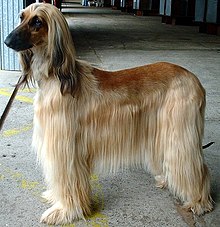Afghan Hound: Difference between revisions
| Line 57: | Line 57: | ||
**[http://clubs.akc.org/ahca/ Afghan Club of America, Inc.] |
**[http://clubs.akc.org/ahca/ Afghan Club of America, Inc.] |
||
* Directories and Informational Pages |
* Directories and Informational Pages |
||
**[http://www.dogbreedinfo.com/afghan.htm Dog Breed Information Center Page] |
|||
**[http://www.dogsindepth.com/hound_dog_breeds/afghan_hound.html Dogs In Depth Page] |
**[http://www.dogsindepth.com/hound_dog_breeds/afghan_hound.html Dogs In Depth Page] |
||
**[http://www.canismajor.com/dog/afghan.html The Afghan Hound Owner's Guide] |
**[http://www.canismajor.com/dog/afghan.html The Afghan Hound Owner's Guide] |
||
Revision as of 05:32, 6 March 2006
| Afghan Hound | |||||||||
|---|---|---|---|---|---|---|---|---|---|
 A gold coated Afghan | |||||||||
| Other names | Baluchi Hound Sage Baluchi Tazi | ||||||||
| Origin | Afghanistan | ||||||||
| |||||||||
| Dog (domestic dog) | |||||||||
The Afghan Hound is a very old sighthound dog breed. Distinguished by its thick, fine, silky coat and its tail with a ring curl at the end, the breed acquired its unique features in the cold mountains of Afghanistan, where it was originally used to hunt wolves, foxes, and gazelles.
Appearance

The Afghan Hound is high-stationed, standing 24 to 28 inches (61-71 cm) in height and weighing 45 to 60 pounds (23-28 kg). The coat may be any colour, but white markings, particularly on the head, are discouraged; many individuals have a black facial mask. However all Afghan Hounds have a white "blaze" on the chest. Some are almost white, but particolor hounds (white with islands of red or black) are not acceptable and may indicate impure breeding. The long, fine-textured coat requires considerable care and grooming. The long topknot and the shorter-haired saddle on the back in the mature dog are distinctive features of the Afghan Hound coat. The high hipbones and unique small ring on the end of the tail are also characteristics of the breed.
Temperament
The temperament of the Afghan Hound is aloof and dignified, but happy and clownish when playing. The breed has the reputation of being the least intelligent dog breed, though this is not necessarily true. The Afghan Hound has many cat-like tendencies and is not slavish in its obedience as are some other breeds. The Afghan hound has a leaning towards independence. Owners should not be surprised if their Afghan hounds sometimes choose to ignore commands. Although seldom used today for hunting in Europe and America where they are popular, Afghans are frequent participants in lure coursing events and are popular as show dogs.
Health
Afghans are a relatively healthy breed; major health issues are allergies, and cancer. Sensitivity to anaesthesia is an issue the Afghan hound shares with the rest of the sighthound group, as sighthounds have relatively low levels of body fat.
Afghan hounds as a whole are a fairly long-lived breed, often living 13-14 years.
History
The breed was always thought to date back at least to the pre-Christian era, and recent discoveries by researchers studying ancient DNA have revealed that the Afghan Hound is in fact one of the most ancient dog breeds, dating back for many thousands of years. Its original native name, Tazi, betrays its connection to the very similar Tasy breed of Russia. The proximity of southern Russia and Afghanistan argue for a common origin for both breeds.
Initially, Afghani people refused to sell their national dog to outsiders; the breed was not seen in Europe and America until after the turn of the 20th century. AKC and CKC did not recognise the Afghan Hound until the 1930s.
On August 3, 2005, Korean scientist Hwang Woo-Suk announced that his team of researchers had become the first team to successfully clone a dog. The dog, an Afghan Hound, was named Snuppy. Later that year, a pattern of lies and fraud by Hwang Woo-Suk came to light, throwing in doubt all his claims. Snuppy, nonetheless, was a genuine clone, and thus the first cloned dog in history. ("The panel found that Hwang's claims last year to have created the world's first cloned dog, however, were genuine.")
Famous Afghans
- Rita from Oliver and Company
- Snuppy (see above)
- What-a-Mess
- Brainy Barker from Krypto the Superdog
External links
- Clubs, Associations, and Socities
- Directories and Informational Pages
- Pedigree Databases
